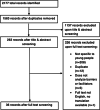Barriers and facilitators for cervical cancer screening among adolescents and young people: a systematic review
- PMID: 33757512
- PMCID: PMC7989022
- DOI: 10.1186/s12905-021-01264-x
Barriers and facilitators for cervical cancer screening among adolescents and young people: a systematic review
Abstract
Background: Though cervical cancer is one of the leading causes of cancer-related death globally, its incidence is nearly entirely preventable. Young people have been an international priority for screening as this population has historically been under-screened. However, in both high-income and low-income countries, young people have not been screened appropriately according to country-specific guidelines. The aim of this systematic review was to systematically characterize the existing literature on barriers and facilitators for cervical cancer screening (CCS) among adolescents and young people globally.
Methods: We conducted a systematic review following PRISMA guidelines of three key databases: Medline-OVID, EMBASE, and CINAHL. Supplementary searches were done through ClinicialTrials.Gov and Scopus. Databases were examined from 1946 until the date of our literature searches on March 12th 2020. We only examined original, peer-reviewed literature. Articles were excluded if they did not specifically discuss CCS, were not specific to individuals under the age of 35, or did not report outcomes or evaluation. All screening, extraction, and synthesis was completed in duplicate with two independent reviewers. Outcomes were summarized descriptively. Risk of bias for individual studies was graded using an adapted rating scale based on the Risk of Bias Instrument for Cross-Sectional Surveys of Attitudes and Practices.
Results: Of the 2177 original database citations, we included 36 studies that met inclusion criteria. The 36 studies included a total of 14,362 participants, and around half (17/36, 47.2%) of studies specifically targeted students. The majority of studies (31/36, 86.1%) discussed barriers and facilitators to Pap testing specifically, while one study analyzed self-sampling (1/36, 2.8%), one study targeted HPV DNA testing (1/36, 2.8%), and the remainder (4/36, 11.1%) were not specified. Our systematic review found that there are three large categories of barriers for young people: lack of knowledge/awareness, negative perceptions of the test, and systemic barriers to testing. Facilitators included stronger relationships with healthcare providers, social norms, support from family, and self-efficacy.
Conclusion: There are unique barriers and facilitators that affect CCS rates in adolescents and young people. Health systems and healthcare providers worldwide should address the challenges for this unique population.
Keywords: Adolescent; Cervical cancer; HPV; Pap smear; Screening; Teenager; Young people; Youth; pap test.
Conflict of interest statement
None.
References
-
- Behtash N, Mehrdad N. Cervical cancer: screening and prevention. Asian Pac J Cancer Prev. 2006;7(4):683. - PubMed
-
- GLOBOCAN 2020: cancer incidence, mortality and prevalence worldwide. IARC Press. Available from https://gco.iarc.fr/today/data/factsheets/cancers/23-Cervix-uteri-fact-s...
-
- World Health Organization (2009). Initiative for vaccines research team of the department of immunization, vaccines and biologicals. Available at: http://www.who.int/vaccinesdocuments/. Accessed March 2020.
Publication types
MeSH terms
LinkOut - more resources
Full Text Sources
Other Literature Sources
Medical
Research Materials
Miscellaneous


